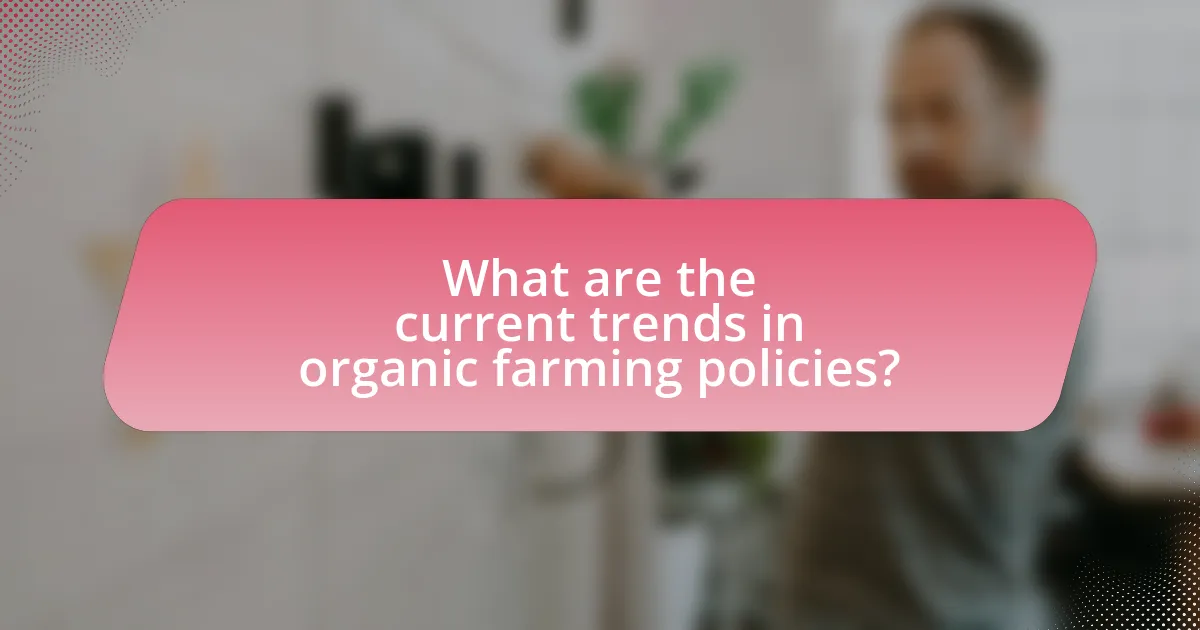The article examines current trends in organic farming policies and their interaction with market demand. It highlights increased government support for organic certification, funding for research, and stricter regulations on labeling, reflecting a global commitment to sustainable agriculture. The evolving regulatory landscape, including the USDA’s Organic Integrity Database, aims to enhance transparency and consumer trust. Additionally, the article discusses the impact of international agreements and trade policies on organic farming practices, as well as the driving factors behind the rising consumer demand for organic products, such as health consciousness and environmental concerns. Finally, it addresses the challenges faced by farmers in meeting market demand and outlines strategies to align with consumer expectations while enhancing the synergy between policies and market trends.

What are the current trends in organic farming policies?
Current trends in organic farming policies include increased government support for organic certification, enhanced funding for research and development, and stricter regulations on organic labeling. Governments worldwide are recognizing the environmental and health benefits of organic farming, leading to policies that promote sustainable agricultural practices. For instance, the European Union’s Common Agricultural Policy has allocated significant funds to support organic farming initiatives, aiming to increase the area under organic cultivation by 25% by 2030. Additionally, countries like the United States have seen the introduction of programs that provide financial assistance to farmers transitioning to organic practices, reflecting a growing commitment to sustainable agriculture. These trends indicate a shift towards more robust frameworks that support organic farming as a viable and essential component of modern agriculture.
How are government regulations evolving in organic farming?
Government regulations in organic farming are evolving towards stricter standards and increased transparency. Recent updates include the implementation of the USDA’s Organic Integrity Database, which enhances traceability and accountability in organic certification. Additionally, the National Organic Program has introduced new rules to address consumer concerns about organic labeling, ensuring that products meet rigorous organic standards. These changes reflect a growing demand for organic products and a commitment to maintaining consumer trust in the organic market.
What specific policies are being implemented to support organic farming?
Specific policies being implemented to support organic farming include financial incentives, regulatory frameworks, and educational programs. Financial incentives, such as subsidies and grants, are provided by governments to encourage farmers to transition to organic practices. Regulatory frameworks establish standards for organic certification, ensuring that products meet specific criteria, which helps maintain consumer trust. Educational programs offer training and resources to farmers on organic farming techniques, promoting sustainable practices. For example, the USDA’s Organic Certification Program outlines the requirements for organic farming and provides resources for farmers to comply with these standards.
How do these policies impact farmers and consumers?
Organic farming policies primarily benefit farmers by providing financial incentives and support for sustainable practices, which can lead to increased profitability. For instance, subsidies for organic certification and funding for research into organic methods help reduce the costs associated with transitioning to organic farming. Consumers benefit from these policies through access to healthier food options and increased availability of organic products, which have been shown to have higher nutritional value. According to the Organic Trade Association, the organic market in the U.S. reached $62 billion in 2020, reflecting growing consumer demand driven by these supportive policies.
What role do international agreements play in organic farming policies?
International agreements play a crucial role in shaping organic farming policies by establishing standards and promoting cooperation among countries. These agreements, such as the Codex Alimentarius and the International Federation of Organic Agriculture Movements (IFOAM) standards, provide a framework for organic certification, ensuring consistency and credibility in organic products across borders. For instance, the European Union’s organic regulation aligns with international standards, facilitating trade and consumer trust. Additionally, these agreements encourage sustainable practices and environmental protection, which are central to organic farming principles, thereby influencing national policies and market demand for organic products.
Which international organizations influence organic farming standards?
The international organizations that influence organic farming standards include the International Federation of Organic Agriculture Movements (IFOAM), the Codex Alimentarius Commission, and the Food and Agriculture Organization (FAO) of the United Nations. IFOAM sets global organic standards and promotes organic agriculture worldwide, while the Codex Alimentarius provides guidelines for food safety and quality, including organic products. The FAO supports sustainable agricultural practices and provides a framework for organic farming policies. These organizations collectively shape the standards and regulations that govern organic farming practices globally.
How do trade agreements affect organic farming practices globally?
Trade agreements significantly influence organic farming practices globally by establishing standards and regulations that can either promote or hinder organic agriculture. For instance, agreements like the Comprehensive and Progressive Agreement for Trans-Pacific Partnership (CPTPP) include provisions that facilitate the trade of organic products by recognizing and harmonizing organic certification processes among member countries. This harmonization can lead to increased market access for organic farmers, allowing them to reach broader international markets. Conversely, trade agreements may also impose stringent regulations that small-scale organic farmers struggle to meet, potentially limiting their competitiveness. Research indicates that countries with favorable trade agreements often see a rise in organic farming adoption, as seen in the European Union, where trade policies have supported the growth of organic sectors by providing financial incentives and reducing trade barriers.

What factors are driving market demand for organic products?
Market demand for organic products is primarily driven by consumer health consciousness, environmental concerns, and increasing availability. Consumers are increasingly aware of the health benefits associated with organic products, such as lower pesticide residues and higher nutrient content, leading to a 12.4% increase in organic food sales in the U.S. from 2020 to 2021, according to the Organic Trade Association. Additionally, growing awareness of environmental sustainability and the negative impacts of conventional farming practices have prompted consumers to choose organic options, as organic farming is associated with reduced chemical use and improved biodiversity. Furthermore, the expansion of organic product availability in mainstream retail channels has made it easier for consumers to access these products, further fueling demand.
How has consumer awareness influenced organic market growth?
Consumer awareness has significantly influenced organic market growth by driving demand for organic products. As consumers become more informed about health benefits, environmental impacts, and food safety associated with organic farming, they increasingly prefer organic options over conventional products. For instance, a 2021 survey by the Organic Trade Association revealed that 82% of consumers believe organic food is healthier, leading to a 12.4% increase in organic food sales in the U.S. from 2019 to 2020. This heightened awareness has prompted retailers to expand their organic offerings, further fueling market growth.
What trends are observed in consumer preferences for organic products?
Consumer preferences for organic products are increasingly driven by health consciousness, environmental concerns, and ethical considerations. A significant trend is the growing demand for organic food, with a report from the Organic Trade Association indicating that U.S. organic food sales reached $62 billion in 2020, reflecting a 12.4% increase from the previous year. Additionally, consumers are prioritizing transparency in sourcing and production methods, with 70% of shoppers expressing a preference for brands that provide clear information about their organic certifications. This shift is further supported by a Nielsen survey showing that 81% of consumers believe that organic products are healthier than conventional options.
How does health consciousness affect organic product sales?
Health consciousness significantly boosts organic product sales as consumers increasingly prioritize health and wellness in their purchasing decisions. This trend is evidenced by a 2021 survey from the Organic Trade Association, which reported that 76% of consumers believe organic foods are healthier than conventional options. As health-conscious individuals seek to avoid synthetic pesticides and genetically modified organisms, they are more likely to choose organic products, driving sales growth in this sector. Additionally, the global organic food market was valued at approximately $120 billion in 2021, reflecting a compound annual growth rate of 10.5%, largely attributed to rising health awareness among consumers.
What economic factors contribute to the demand for organic farming?
The demand for organic farming is primarily driven by consumer willingness to pay a premium for organic products, which is influenced by increasing health consciousness and environmental awareness. As consumers become more informed about the benefits of organic farming, such as reduced pesticide exposure and sustainable agricultural practices, they are more likely to choose organic options, even at higher prices. According to a report by the Organic Trade Association, the U.S. organic market reached $62 billion in sales in 2020, reflecting a 12.4% increase from the previous year, indicating strong consumer demand. Additionally, government policies that support organic farming through subsidies and certifications further enhance market demand by making organic products more accessible and appealing to consumers.
How do pricing strategies impact consumer choices in organic markets?
Pricing strategies significantly influence consumer choices in organic markets by affecting perceived value and accessibility. For instance, premium pricing can create an impression of higher quality, attracting consumers who prioritize health and sustainability. Conversely, competitive pricing can broaden market reach, appealing to price-sensitive consumers. Research indicates that 70% of consumers are willing to pay more for organic products, highlighting the impact of pricing on purchasing decisions. Additionally, promotional pricing strategies, such as discounts or bundling, can enhance consumer interest and increase sales volume, demonstrating that effective pricing strategies are crucial in shaping consumer behavior in organic markets.
What is the role of supply chain dynamics in organic product availability?
Supply chain dynamics play a crucial role in the availability of organic products by influencing the efficiency and effectiveness of sourcing, production, distribution, and retail processes. These dynamics determine how quickly and reliably organic products can reach consumers, impacting factors such as inventory levels, pricing, and product freshness. For instance, disruptions in supply chain logistics, such as transportation delays or sourcing challenges, can lead to shortages of organic products in the market. Additionally, the increasing demand for organic products necessitates a responsive supply chain that can adapt to fluctuations in consumer preferences and regulatory changes, ensuring that organic products are consistently available to meet market demand.

How do organic farming policies and market demand interact?
Organic farming policies and market demand interact by shaping the availability and accessibility of organic products, which in turn influences consumer purchasing behavior. Policies such as subsidies for organic farmers and regulations that define organic standards create an environment that encourages organic production. For instance, the USDA’s National Organic Program establishes guidelines that help consumers trust organic labels, thereby increasing market demand. As demand rises, farmers are incentivized to adopt organic practices, leading to a cycle where supportive policies and consumer preferences reinforce each other. This interaction is evident in the growth of the organic market, which reached $62 billion in sales in the U.S. in 2020, reflecting both consumer interest and the impact of favorable policies.
What is the relationship between policy changes and market trends?
Policy changes directly influence market trends by altering regulations, incentives, and consumer behavior. For instance, when governments implement subsidies for organic farming, it can lead to increased production and lower prices, thereby boosting market demand for organic products. A study by the USDA found that policy initiatives supporting organic agriculture resulted in a 20% increase in organic crop acreage from 2012 to 2017, demonstrating a clear correlation between supportive policies and market growth.
How do new regulations affect consumer trust in organic products?
New regulations enhance consumer trust in organic products by ensuring stricter standards and transparency in labeling. These regulations often include rigorous certification processes that verify the organic status of products, which can lead to increased consumer confidence. For instance, a study by the Organic Trade Association found that 82% of consumers are more likely to purchase organic products when they understand the certification process, indicating that clear regulations directly correlate with consumer trust.
What impact do subsidies have on organic farming market demand?
Subsidies significantly increase market demand for organic farming by lowering production costs and making organic products more affordable for consumers. When governments provide financial support to organic farmers, it enables them to compete more effectively with conventional agriculture, which often benefits from economies of scale. For instance, a study by the USDA found that direct payments and cost-sharing programs for organic farmers led to a 20% increase in organic acreage and a corresponding rise in consumer purchases of organic products. This demonstrates that subsidies not only enhance the viability of organic farming but also stimulate consumer interest and demand in the organic market.
What challenges do farmers face in meeting market demand under current policies?
Farmers face significant challenges in meeting market demand under current policies, primarily due to regulatory constraints, fluctuating prices, and limited access to resources. Regulatory constraints often include stringent certification processes for organic farming, which can delay market entry and increase costs. Fluctuating prices for organic products can create uncertainty, making it difficult for farmers to plan production effectively. Additionally, limited access to resources such as funding, technology, and information can hinder farmers’ ability to scale operations and meet consumer demand. According to the USDA, organic farmers reported that 30% of their challenges stem from market access issues, highlighting the impact of current policies on their ability to compete effectively.
How do compliance costs affect small-scale organic farmers?
Compliance costs significantly burden small-scale organic farmers by reducing their profit margins and limiting their ability to compete in the market. These costs arise from the need to adhere to regulatory standards, which often include expenses related to certification, record-keeping, and inspections. For instance, a study by the USDA found that organic certification can cost small farmers between $1,000 to $2,000 annually, which can be a substantial percentage of their total income. Consequently, high compliance costs can deter new entrants into organic farming and push existing farmers to abandon organic practices, ultimately affecting the diversity and sustainability of the organic farming sector.
What strategies can farmers adopt to align with market expectations?
Farmers can adopt several strategies to align with market expectations, including diversifying crop production, implementing sustainable practices, and engaging in direct marketing. Diversifying crop production allows farmers to meet specific consumer demands and reduce risk associated with market fluctuations. Implementing sustainable practices, such as organic farming, not only meets the growing consumer preference for environmentally friendly products but also often qualifies farmers for premium pricing and subsidies. Engaging in direct marketing, such as farmers’ markets or community-supported agriculture (CSA), enables farmers to establish a direct connection with consumers, ensuring that their products meet local market demands. These strategies are supported by the increasing trend of consumers seeking organic and locally sourced products, as evidenced by the Organic Trade Association reporting a 12.4% increase in organic food sales in 2020, highlighting the growing market for organic produce.
What best practices can enhance the synergy between policies and market demand?
Best practices that can enhance the synergy between policies and market demand include aligning agricultural policies with consumer preferences and promoting transparency in organic farming standards. By ensuring that policies reflect the growing consumer demand for organic products, governments can create a supportive environment for organic farmers. For instance, the USDA’s National Organic Program has established clear standards that help consumers trust organic labels, thereby increasing market demand. Additionally, engaging stakeholders, including farmers, consumers, and retailers, in policy development fosters collaboration and ensures that policies are responsive to market needs. This approach has been shown to improve the effectiveness of organic farming initiatives, as evidenced by the increase in organic sales, which reached $62 billion in the U.S. in 2020, reflecting a 12.4% growth from the previous year.















